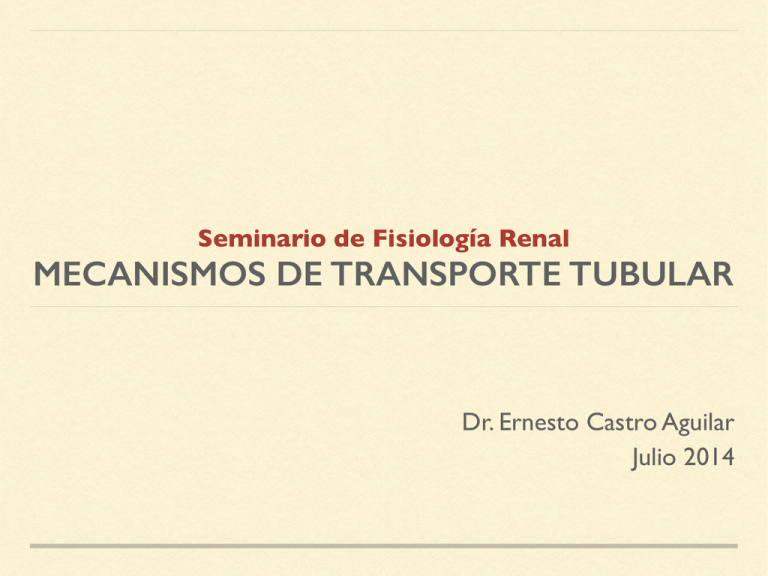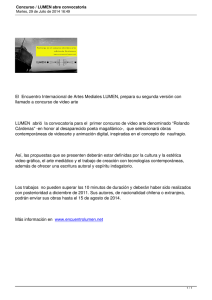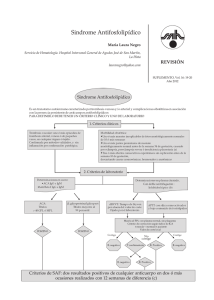Mecanismo de transporte tubular
Anuncio

! Seminario de Fisiología Renal MECANISMOS DE TRANSPORTE TUBULAR Dr. Ernesto Castro Aguilar Julio 2014 TRANSPORTE EPITELIAL Filtrado glomerular sufre una serie de modificaciones antes de convertirse en orina Reabsorción y secreción de solutos y fluidos TRANSPORTE EPITELIAL TRANSPORTE TUBULAR Propiedades de membrana luminal deben ser diferentes a membrana basolateral. Distribución asimétrica de proteínas transportadoras. Transporte transcelular y paracelular (limitado por uniones estrechas) TRANSPORTE PASIVO Difusión simple: gradiente electroquímico. No requiere energía Difusión facilitada: interacción de molécula o ión con transportador de membrana que favorece paso por membrana bilipídica. Difusión por canal: favorece paso a una tasa mayor. REABSORCIÓN Movimiento de solutos o agua desde lúmen tubular hacia la sangre Importante para manejo de Na+, Cl-, H2O, bicarbonato, glucosa, aminoácidos , proteínas, fosfatos, Ca2+, Mg2+, urea, ácido úrico y otras moléculas SECRECIÓN Movimiento de solutos desde la sangre o intersticio celular hacia el lúmen tubular. Manejo de H+, K+, amonio (NH4+) y ácidos y bases orgánicas. TRANSPORTE ACTIVO Energía es requerida para transportar iones contra gradiente electroquímico. Energía derivada de metabolismo celular Mecanismo más importante es el de la bomba Na-K. Confinada a membrana basolateral. Energía de hidrólisis de ATP. NA+-K+-ATPASA Clave para el funcionamiento de mecanismos de transporte pasivo. Mantiene concentración intracelular de sodio (10-20 mmol/L) y de potasio (150mmol/L) Necesario para funcionamiento de cotransportadores, antiportadores. TÚBULO PROXIMAL Adaptado para reabsorción en “masa”. Células con borde en cepillo en superficie apical Membrana basolateral con pliegues que también aumentan superficie. Ricas en mitocondrias y vacuolas lisosomales Pocas uniones intercelulares Major Transport Mechanisms Along the Nephron DCT Lumen Principal cells Interstitium Lumen Na+ Na+ Cl− K+ Na+ Na+ K+ K+ K+ K+ Cl− Ca2+ Interstitium Ca2+ ! Ca2+ Na+ Intercalated cells PCT Lumen Na+ Glucose Na+ Amino acids Na+ Phosphate Na+ Citrate Cl− Formate/Oxalate Na+ H+ Alpha Interstitium Glucose Amino acids Na+ K+ K+ Cl− K+ Cl− Na+ HCO3− H+ HCO3− Cl− H+ K+ Cl− Beta H+ HCO3− Cl− Cl− TUBULO PROXIMAL Responsable de reabsorción de Na+, K+, Cl- y HCO3-. Reabsorción prácticamente completa de glucosa, aminoácidos y proteínas de bajo peso molecular (b-microglobulinas, proteína ligadora de retinol). Reabsorción 60% calcio, 80% fosfato y 50% urea TÚBULO PROXIMAL Altamente permeable a agua (no hay generación de gradiente osmótico) S2 y S3: secreción de ácidos y bases orgánicas débiles (diuréticos y PAH). ASA DE HENLE Conformada por: Pars recta de TP (asa descendente gruesa) Asas delgadas descendente y ascedente (presente en nefronas con asas largas) Asa gruesa ascendente Mácula densa Responsable de reabsorción mayor de Mg2+ y concentración o dilución de orina. limbs of deep nephrons). (Recent evidence suggests that the thin Transport Mechanisms in the Thick Ascending Limb Lumen Cells of thick ascending limb Interstitial fluid Na+ K+ Na+ H+ Na+ K+ Ca2+ Mg2+ + K+ K+ 2Cl− Na+ K+ K+ Cl− Cl− Paracellular diffusion Lumen-positive potential difference Figure 2.12 Transport mechanisms in the thick ascending limb of Henle. The major cellular entry mechanism is the Na+-K+-2Cl− cotransporter. The transepithelial potential difference drives paracellular trans- again driven b low intracellul lumen throug to a much less apical NKCC of action of lo exits the cell through basol also re-enters potassium cha necessary for n presumably be the transporte lower than tha sible for gener in this segmen reabsorption reabsorbed tra larly (see Fig. reabsorbed by TAL in the ab the tubular fl name diluting The U-sha Henle, the di ascending lim in the TAL ar TÚBULO DISTAL Conformado por: túbulo contorneado distal, túbulo conector y ducto colector Conducto colector cortical: 2 células Principales : reabsorción de Na+ y secreción de K+. ENaC: genera gradiente eléctrico Intercaladas: secreción de H+ (alfa) o bicarbonato (beta) TÚBULO DISTAL Ducto colector medular Pérdida de células intercaladas Modificación de células principales: no secretan K+ en esta porción. Major Transport Mechanisms Along the Nephron DCT Lumen Principal cells Interstitium Lumen Na+ Na+ Cl− K+ Na+ Na+ K+ K+ K+ K+ Cl− Ca2+ Interstitium Ca2+ ! Ca2+ Na+ Intercalated cells PCT Lumen Na+ Glucose Na+ Amino acids Na+ Phosphate Na+ Citrate Cl− Formate/Oxalate Na+ H+ Alpha Interstitium Glucose Amino acids Na+ K+ K+ Cl− K+ Cl− Na+ HCO3− H+ HCO3− Cl− H+ K+ Cl− Beta H+ HCO3− Cl− Cl− CHAPT Renal Sodium Handling Distal convoluted tubule 8% Cortex 5% Proximal convoluted tubule 50% Proximal straight tubule 15% Outer medulla 3% Collecting duct Connecting tubule 35% 20% Thick ascending limb 7% Inner medulla Thin descending limb Thin ascending limb !1% Figure 2 the neph resent th tered load within the remaining the proxim day-to-day in the dist Renal Potassium Handling Distal convoluted tubule 10% Cortex Proximal convoluted tubule 45% Proximal straight tubule Outer medulla Inner medulla Connecting tubule Thick ascending limb Thin descending limb Thin ascending limb 1%–100% Collecting duct Figure the nep ages rea because but mos proximal limb of H load reac connecti late dist able and excretion Defects in Transport Proteins Resulting in Renal Disease Transporter Consequence of Mutation Peritubular Capi Fluid Rea Lumen Nor Proximal tubule Proximal Tubule Apical Na+-cystine cotransporter Cystinuria Apical Na+-glucose cotransporter (SGLT2) Renal glycosuria Proximal renal tubular acidosis Basolateral Na+-HCO3– cotransporter Na+ + H2O Na+ K Paracellular backflux Intracellular H+-Cl– exchanger (CIC5) Dent disease Thick Ascending Limb Apical Na+-K+-2Cl– cotransporter Bartter syndrome type 1 Apical K+ channel Bartter syndrome type 2 Cl– channel Bartter syndrome type 3 Basolateral Cl– channel accessory protein Bartter syndrome type 4 Basolateral Distal Convoluted Tubule Apical Na+-Cl– cotransporter Gitelman’s syndrome Reduced peritubular ca Na+ + H2O Na+ K Increased paracellular backflux Collecting Duct Apical Na+ channel (principal cells) Overexpression: Liddle’s syndrome Underexpression: pseudohypoaldosteronism type 1b Aquaporin-2 channel (principal cells) Nephrogenic diabetes insipidus Basolateral Cl–/HCO3– exchanger (intercalated cells) Distal renal tubular acidosis Apical H+-ATPase (intercalated cells) Distal renal tubular acidosis (with or without deafness) Figure 2.10 Genetic defects in transport proteins resulting in renal disease. For more detailed coverage of these clinical conditions, Figure 2.11 Physical factors an Influence of peritubular capillary onc proximal tubules. Uptake of reabs determined by the balance of hydro the capillary wall. Compared with th tubular capillary hydrostatic (Ppc) and high, respectively, so that uptake of capillaries is favored. If peritubular (or hydrostatic pressure increases), sure increases, and more fluid may larly; net reabsorption in proximal tu Major Transport Mechanisms Along the Nephron DCT Lumen Principal cells Interstitium Lumen Na+ Na+ Cl− K+ Na+ Na+ K+ K+ K+ K+ Cl− Ca2+ Interstitium Ca2+ ! Ca2+ Na+ Intercalated cells PCT Lumen Na+ Glucose Na+ Amino acids Na+ Phosphate Na+ Citrate Cl− Formate/Oxalate Na+ H+ Alpha Interstitium Glucose Amino acids Na+ K+ K+ Cl− K+ Cl− Na+ HCO3− H+ HCO3− Cl− H+ K+ Cl− Beta H+ HCO3− Cl− Cl− Renal Anatomy and Physiology Proteins Resulting Disease Consequence of Mutation Peritubular Capillaries Modulate Fluid Reabsorption Lumen Cystinuria Na+ + H2O Na+ K Renal glycosuria Proximal renal tubular r acidosis Normal Proximal tubule Interstitial fluid Peritubular capillary Ppc (low) Paracellular backflux πpc (high) 5) Dent disease Fluid reabsorbed Bartter syndrome type 1 Bartter syndrome type 2 Reduced peritubular capillary oncotic pressure Bartter syndrome type 3 Bartter syndrome type 4 Gitelman’s syndrome Overexpression: Liddle’s syndrome Underexpression: pseudohypoaldosteronism type 1b Nephrogenic diabetes insipidus Na+ + H2O Na+ K Increased paracellular backflux ↓ πpc Raised interstitial pressure Less fluid reabsorbed Figure 2.11 Physical factors and proximal tubular reabsorption. Influence of peritubular capillary oncotic pressure on net reabsorption in proximal tubules. Uptake of reabsorbate into peritubular capillaries is determined by the balance of hydrostatic and oncotic pressures across FIN

